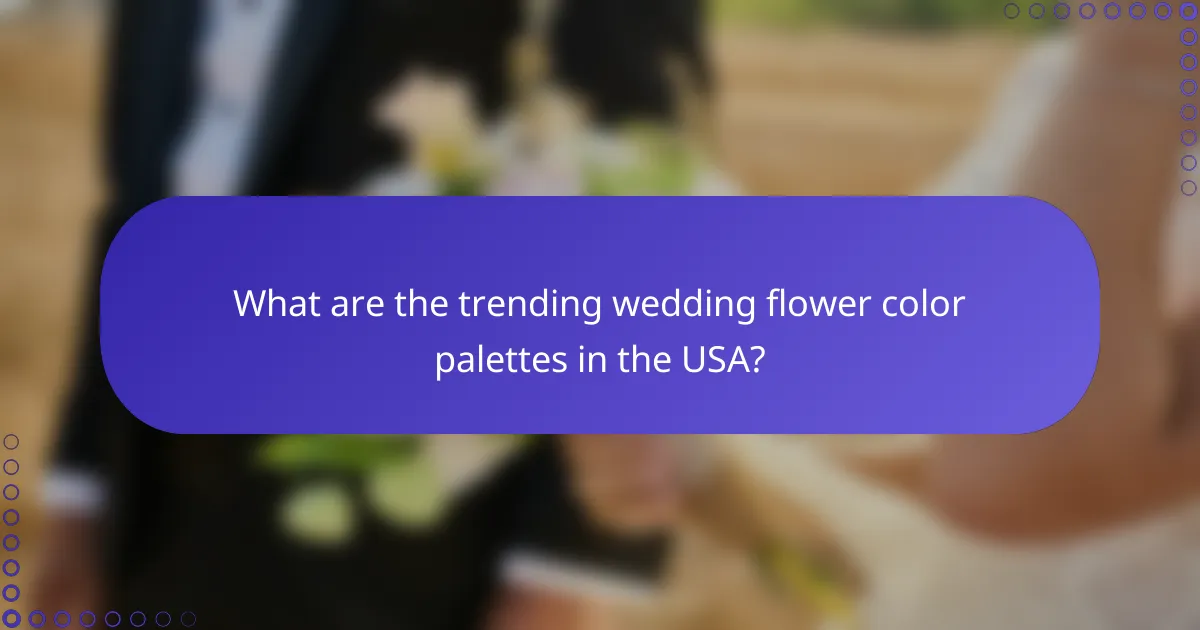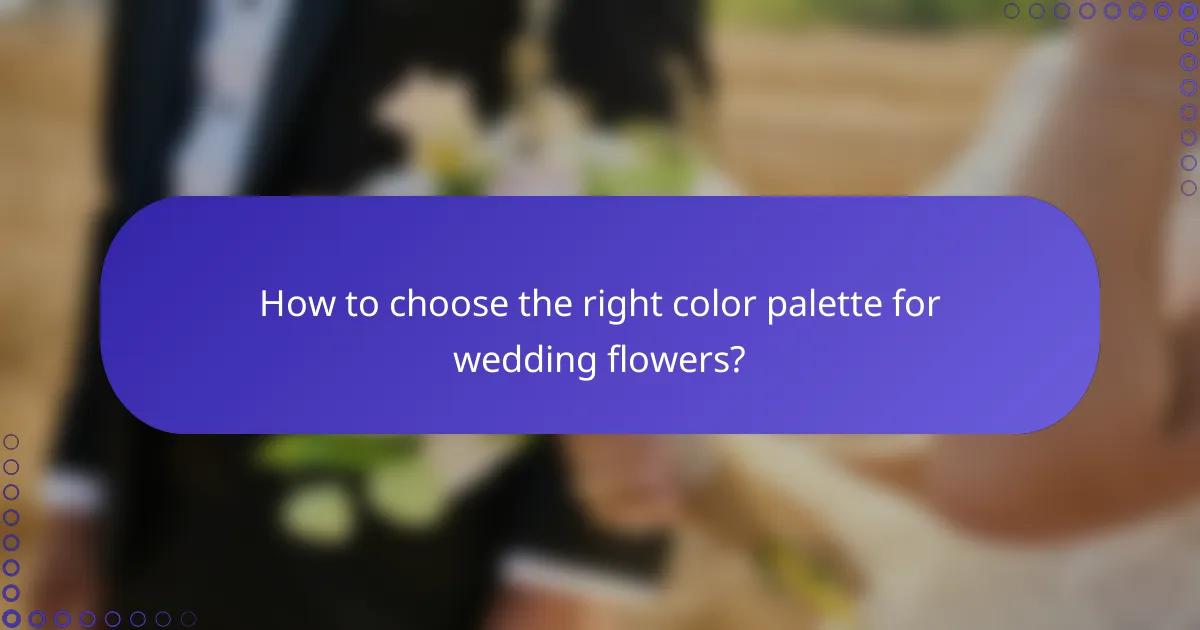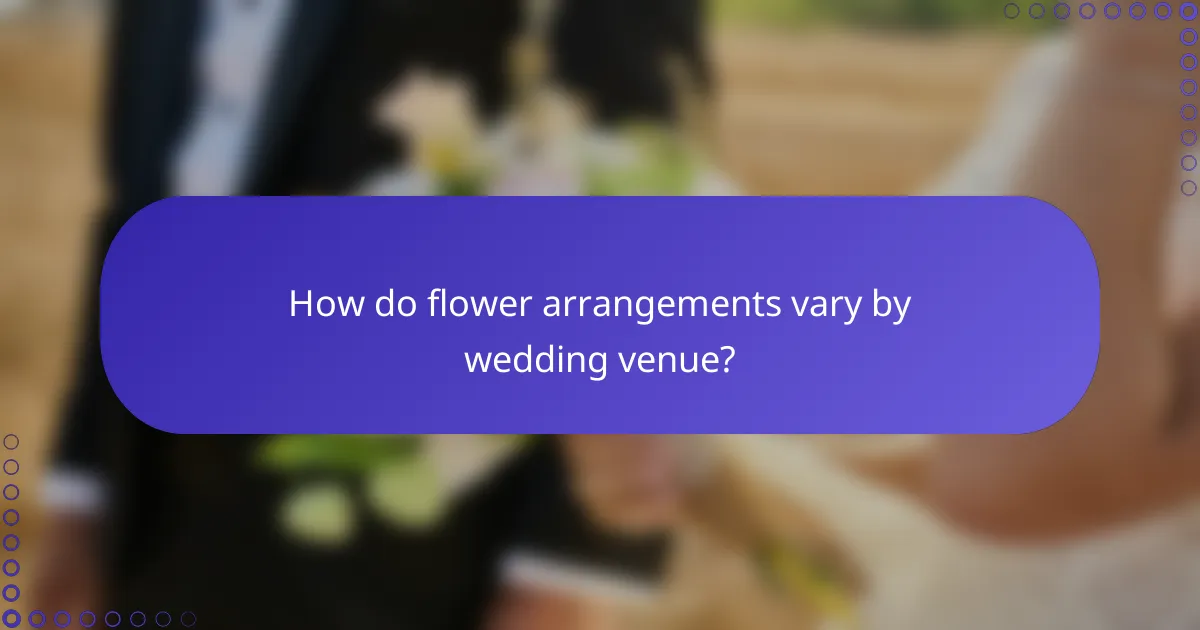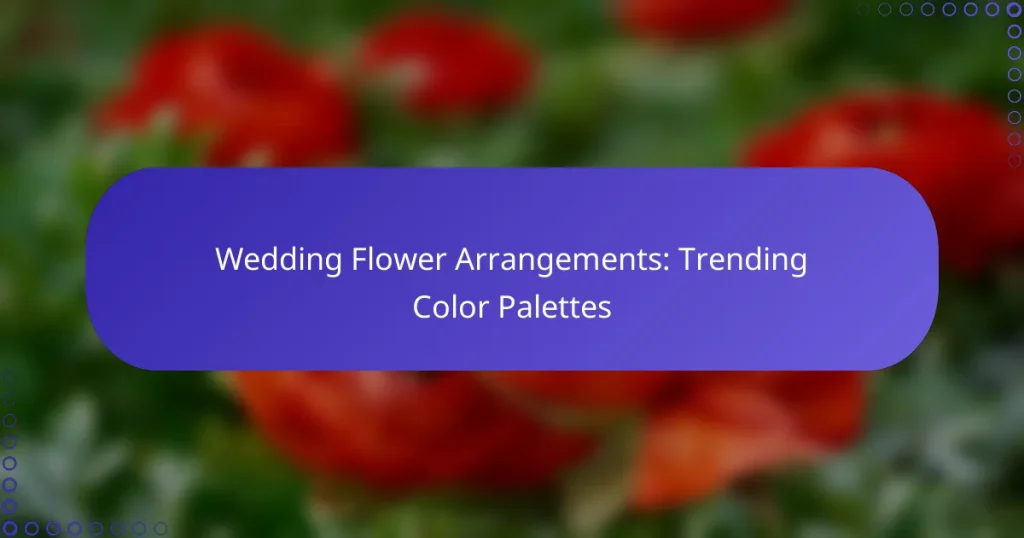Trending wedding flower color palettes in the USA beautifully blend modern aesthetics with timeless elegance, allowing couples to enhance their wedding themes while embracing seasonal blooms. Selecting the right color palette is essential, as it influences the overall aesthetic and creates a cohesive look for the special day.

What are the trending wedding flower color palettes in the USA?
Trending wedding flower color palettes in the USA reflect a mix of modern aesthetics and timeless elegance. Couples are increasingly opting for combinations that enhance their wedding themes while resonating with seasonal blooms.
Pastel shades
Pastel shades are a popular choice for weddings, offering a soft and romantic vibe. Colors like blush pink, lavender, and mint green create a delicate atmosphere, perfect for spring and summer ceremonies.
When using pastel shades, consider mixing different hues to add depth. For instance, pairing pale pink roses with light blue hydrangeas can create a visually appealing arrangement. These colors work well in both bouquets and centerpieces.
Bold jewel tones
Bold jewel tones such as emerald green, deep blue, and rich burgundy are gaining traction for their dramatic impact. These colors add sophistication and can be particularly striking for fall and winter weddings.
To effectively use jewel tones, balance them with lighter shades or metallic accents. For example, a deep red dahlia can be complemented by gold foliage, creating a luxurious look. This palette is ideal for couples seeking a vibrant yet elegant aesthetic.
Earthy neutrals
Earthy neutrals, including taupe, beige, and soft browns, are trending for their natural and organic feel. These colors work well in rustic or bohemian-themed weddings, offering a grounded and serene atmosphere.
Incorporating earthy neutrals can be achieved through a mix of dried flowers and fresh blooms. For instance, using pampas grass alongside cream-colored roses can create a stunning, textured arrangement that feels both modern and timeless.
Vibrant tropical colors
Vibrant tropical colors like bright orange, hot pink, and sunny yellow are perfect for couples looking to make a bold statement. These colors evoke a sense of fun and are especially popular for destination weddings or summer celebrations.
When using tropical colors, consider incorporating tropical foliage such as palm leaves or monstera. This not only enhances the color palette but also adds a lush, exotic feel to the arrangements, making them truly stand out.
Classic white and green
The classic combination of white and green remains a timeless choice for weddings. White flowers like roses, lilies, and peonies paired with fresh greenery create an elegant and sophisticated look suitable for any season.
To keep this palette fresh, experiment with different textures and shapes. Adding eucalyptus or ferns can provide depth and interest to a predominantly white arrangement. This approach ensures a clean, cohesive look that never goes out of style.

How to choose the right color palette for wedding flowers?
Choosing the right color palette for wedding flowers involves considering the season, the wedding theme, and your personal style. A well-selected palette can enhance the overall aesthetic and create a cohesive look for your special day.
Consider the season
The season of your wedding plays a significant role in determining the color palette for your flowers. Spring often features pastels like soft pinks and light yellows, while summer may embrace vibrant hues such as bright oranges and deep blues. Autumn typically showcases rich colors like burgundy and gold, and winter can include icy blues and whites.
To align your floral choices with the season, consider using flowers that are naturally in bloom during that time. This not only ensures availability but also enhances the seasonal feel of your arrangements.
Match with wedding theme
Your wedding theme should guide your color palette selection for flowers. For instance, a rustic theme might benefit from earthy tones and wildflower arrangements, while a modern theme could call for sleek, monochromatic designs. Think about how the colors will complement your venue and decor.
Creating a mood board can help visualize how different colors and flower types work together within your chosen theme. This can include fabric swatches, invitation designs, and other decor elements to ensure harmony throughout your wedding.
Reflect personal style
Your personal style should be a central factor in selecting a color palette for your wedding flowers. Consider colors that resonate with you and your partner, whether they are bold and bright or soft and subtle. This is an opportunity to express your individuality through floral choices.
Don’t hesitate to incorporate unique elements, such as favorite colors or meaningful flowers, to make the arrangements truly yours. Remember, your wedding flowers should not only look beautiful but also reflect who you are as a couple.

What are popular flower types for each color palette?
Popular flower types vary significantly based on the chosen color palette for wedding arrangements. Each color scheme can enhance the overall aesthetic, making certain flowers more suitable for specific themes.
Roses for pastel shades
Roses are a classic choice for pastel color palettes, offering a soft and romantic look. Light pink, peach, and cream roses blend beautifully to create a delicate atmosphere.
When selecting roses, consider mixing different varieties, such as garden roses and spray roses, to add texture and depth. Pairing them with greenery like eucalyptus can enhance the pastel theme.
Dahlias for bold jewel tones
Dahlias shine in bold jewel tones, making them ideal for vibrant wedding themes. Colors like deep red, royal blue, and emerald green can create a striking visual impact.
For a cohesive look, combine dahlias with other rich-hued flowers such as chrysanthemums or zinnias. This combination can evoke a luxurious feel, perfect for evening weddings.
Succulents for earthy neutrals
Succulents are excellent for earthy neutral palettes, bringing a modern and organic touch to floral arrangements. Shades of green, beige, and soft browns work harmoniously with these unique plants.
Incorporating succulents with flowers like white roses or dried grasses can enhance the natural aesthetic. This combination is particularly popular for rustic or bohemian-themed weddings.
Orchids for vibrant tropical colors
Orchids are synonymous with vibrant tropical colors, making them a standout choice for lively wedding arrangements. Bright hues like fuchsia, orange, and yellow can energize the overall decor.
Mixing orchids with tropical foliage, such as palm leaves or monstera, can create a lush and exotic atmosphere. This pairing is ideal for destination weddings or summer celebrations.

How do flower arrangements vary by wedding venue?
Flower arrangements differ significantly based on the wedding venue, as each setting influences the style, size, and types of flowers used. Factors such as indoor versus outdoor locations, available lighting, and overall ambiance play crucial roles in determining the floral design.
Indoor venues
Indoor venues often allow for more controlled environments, which can enhance the longevity of floral arrangements. Popular choices include lush centerpieces and dramatic installations that complement the venue’s decor. Consider using flowers that thrive in lower light, such as roses or lilies, to create a romantic atmosphere.
When selecting arrangements for indoor settings, think about the scale of the space. Larger venues may benefit from tall centerpieces or cascading floral designs, while smaller spaces might require more compact arrangements to avoid overwhelming the room.
Outdoor ceremonies
Outdoor ceremonies present unique challenges and opportunities for flower arrangements. Natural light can enhance the colors of flowers, making vibrant palettes like coral, peach, and lavender particularly appealing. However, consider the weather; flowers that can withstand heat and wind, such as sunflowers or daisies, are ideal for outdoor settings.
Additionally, think about the surrounding landscape. Arrangements can be designed to harmonize with natural elements, using wildflowers or greenery that echo the outdoor environment. Incorporating local blooms can also add a personal touch and support local florists.
Destination weddings
Destination weddings often require careful planning regarding flower arrangements due to travel logistics and local availability. It’s advisable to consult with local florists who understand the regional climate and flower options. Popular destination wedding colors often reflect the locale, such as tropical hues for beach weddings or earthy tones for rustic mountain settings.
When planning, consider shipping costs and the potential for flowers to wilt during transit. Opting for seasonal and locally sourced flowers can reduce costs and ensure freshness. Additionally, think about how arrangements can be reused throughout the event, such as using ceremony flowers for the reception to maximize value.

What are the costs associated with wedding flower arrangements?
The costs of wedding flower arrangements can vary significantly based on factors such as the types of flowers chosen, the complexity of the arrangements, and the overall size of the wedding. Typically, couples can expect to allocate a portion of their budget specifically for floral designs, which can range from a few hundred to several thousand dollars.
Average pricing per bouquet
On average, wedding bouquets can cost anywhere from $100 to $300, depending on the flowers used and the design’s intricacy. Simple arrangements with seasonal blooms tend to be more affordable, while exotic or out-of-season flowers can drive prices higher. For larger floral displays, such as centerpieces, costs may range from $50 to $150 each.
Cost factors by flower type
The type of flowers selected plays a crucial role in determining the overall cost of wedding arrangements. Common flowers like roses and daisies are generally more budget-friendly, while peonies and orchids can be significantly more expensive due to their growing conditions and availability. Additionally, using local and seasonal flowers can help reduce costs.
Budgeting tips for floral arrangements
To effectively budget for floral arrangements, start by setting a clear overall budget for flowers and stick to it. Consider prioritizing key arrangements, such as the bridal bouquet and centerpieces, while opting for simpler designs in less prominent areas. Another tip is to consult with a florist early on to explore options that fit your budget without compromising on style.


